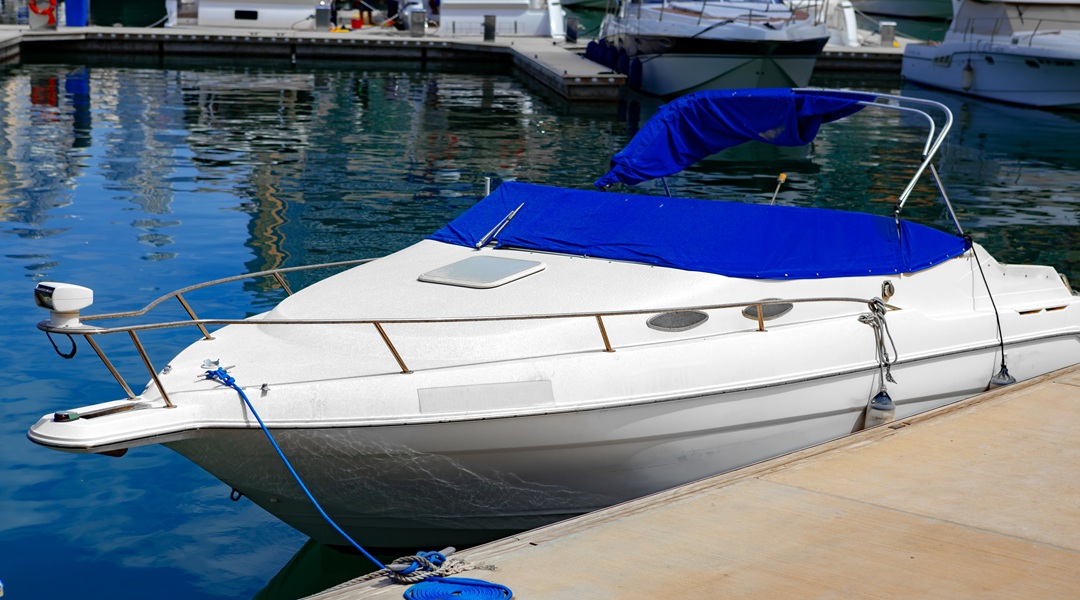You know that a good boat cover shields your vessel from the elements, but what happens when it begins to falter? Watch out for key signs like wear and tear, failing fasteners or straps, water pooling issues, unsightly mold spots, color fading indicating fabric weakness, fraying stitches needing care, or any holes demanding swift repair. These red flags signal your boat cover might be due for an overhaul.
If you’re spotting unfamiliar threads loosening up on the canvas surface; it’s time to inspect closely for wear and tear.
Inspect for Wear and Tear
Examine your boat cover carefully for signs of wear and tear that could lead to damage. Start by looking over the fabric for any areas that appear thinner or excessively stretched, as these parts are more prone to ripping. You should also feel for stiff sections; exposure to sun and harsh weather can make materials brittle.
Check seams and folds, especially since they handle most of the stress and might split with continued use. Even small abrasions can signal bigger problems down the line if left unattended. If you notice such issues during inspection, consider our services for boat cover repair before minor wear becomes a major concern.
Check Fasteners and Straps Integrity
- Unusual Sounds and Feelings: If your boat starts making sounds you don’t recognize, pay attention. An unfamiliar noise under the hood could suggest a hidden issue begging for a fix. It’s smart to consult your mechanic right after detecting strange vibrations or grinding noises.
- Overheating Engines: Engines heat up; it’s their thing, especially when they’re pushed hard. But an engine that overheats more than usual might be signaling trouble inside. To sidestep major damage from repeated overheating incidents, get this checked out promptly.
- Persistent Leaks: Leaks on your vessel spell big trouble if ignored for too long, even small ones can lead to significant harm over time Clear signs of leaking demand immediate action to prevent safety hazards and nasty damage onboard If you spot leaks frequently, ring up the marina sooner rather than later so things won’t spiral out of control.
Water Pooling Indicates Trouble
Spotting water pooling on your boat cover is a warning sign you should not ignore. It signals that the cover may no longer properly support or protect your vessel. Even with a snug fit, subtle fabric relaxation can lead to sagging and create unintended collection points for moisture.
This issue can escalate when tarps shift after exposure to winds or regular boat movement, exacerbating the problem of pooling areas. Since these pools of water add weight and stress to the material, they increase wear risk over time, which ultimately compromises the integrity of your cover’s protective capabilities, vastly reducing its lifespan if left unchecked. Regularly adjusting tie-downs and supports helps prevent sagging; however, check often because even small amounts of collected water suggest it’s time for maintenance or potentially an upgrade in support systems from reliable solutions provided by TH-Marine.
Mildew or Mold Spots Alert
- Mildew or Mold Spots Alert: Your first red flag. You may spot black, green, or white spots on your boat cover which signals mildew or mold presence. It’s a glaring sign that moisture has been trapped and the fabric is suffering because of it. Cleaning these areas promptly is crucial; if ignored, deterioration will set in fast.
- Stain Identification: Know what you’re dealing with. Different stains require different cleaning methods, some might just need water and elbow grease while others could call for special treatments. Recognize stain types with our detailed guide to ensure proper care for your boat cover. Regular cleanings are vital in keeping such blemishes at bay.
Noticeable Color Fading and Weakness
If your boat cover is looking faded or starting to feel brittle, it may be time for a professional repair. Prolonged exposure to the sun and weather can degrade the fabric, especially in high-stress areas like seams, folds, and sun-exposed sections.
At The Boat Lift Company, we assess covers for UV damage and material breakdown to determine whether reinforcement, re-stitching, or panel replacement is the best solution. Our repair services not only restore the cover’s strength and appearance but also help extend its lifespan, protecting your boat and your investment season after season.
Stitching Frays Require Attention
- Early Sign of Damage: You’ll notice the thread in some areas has started to pull away. This signals that your cover’s stitching is coming loose, which compromises its overall integrity. Prompt action can prevent further unravelling or tears, ensuring long-term protection for your boat.
- Stitch Strength Loss: When the stitch lines begin losing their tightness, it’s a clear warning sign. It means moisture and debris might find an easier path under the cover, threatening your boat’s condition when unused. We recommend addressing this issue swiftly to maintain optimal coverage security.
- Visible Fraying Evidence: If you see frayed edges along seams or stress points, don’t wait up on repairs too long it won’t mend itself without help. Such wear could soon turn into bigger issues like gaping holes if left unchecked. Take these visual cues seriously as they’re critical for safeguarding against potential damage from environmental elements.
Holes or Tears Demand Quick Action
If you spot a tear or hole in your boat cover, take swift action to avoid further damage. Small punctures can quickly expand under stress from wind and water, compromising the cover’s integrity. Regular checks for any breaches are crucial; they expose your vessel to unpredictable weather and debris if ignored.
Repair kits exist that allow easy patching of minor issues before they escalate into costly problems. Our covers are built to be durable but not invincible; vigilance ensures longevity and protection for your investment on the waves. Lastly, remember that timely maintenance today prevents headaches down the line, the effort is worth it for boating with peace of mind.
Notice rips or your boat cover sagging? It might be waving a red flag for repair. Consider its age, too, daily sun beating down can weaken fabrics over time.
Water pooling is another clear signal; proper covers don’t collect rain like a bowl! Also, watch for color fading, which suggests the material is breaking down and losing strength. If you spot these signs, take quick action to fix that cover.
Give The Boat Lift Company a shout; they’ve got the expertise to breathe new life into your boat’s shield against the elements.

